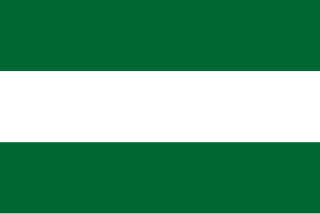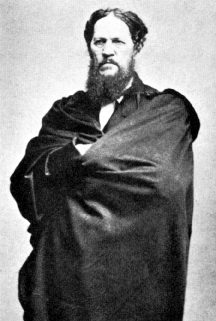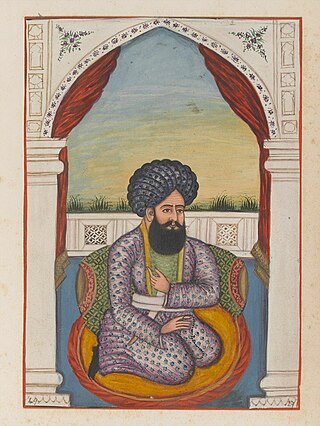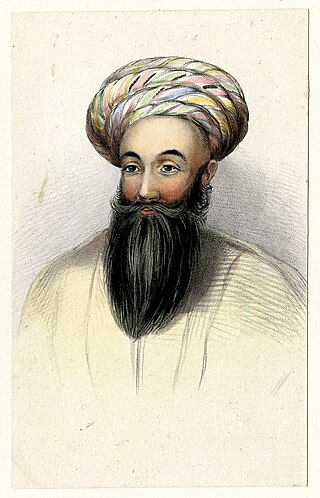Afghan Turkestan, also known as Southern Turkestan, is a region in northern Afghanistan, on the border with the former Soviet republics of Turkmenistan, Uzbekistan and Tajikistan. In the 19th century, there was a province in Afghanistan named Turkestan with Mazari Sharif as provincial capital. The province incorporated the territories of the present-day provinces of Balkh, Kunduz, Jowzjan, Sar-e Pol, and Faryab. In 1890, Qataghan-Badakhshan Province was separated from Turkestan Province. It was later abolished by Emir Abdur Rahman.

The Durrani Empire or the Afghan Empire, also known as the Sadozai Kingdom, was an Afghan empire that was founded by Ahmad Shah Durrani in 1747, that spanned parts of Central Asia, the Iranian plateau, and the Indian Subcontinent. At its peak, it ruled over the present-day Afghanistan, much of Pakistan, parts of northeastern and southeastern Iran, eastern Turkmenistan, and northwestern India. Next to the Ottoman Empire, the Durrani Empire is considered to be among the most significant Islamic Empires of the 18th century.

Mazar-i-Sharīf, also known as Mazar-e Sharīf or simply Mazar, is the fourth-largest city in Afghanistan by population, with an estimated 500,207 residents in 2021. It is the capital of Balkh province and is linked by highways with Kunduz in the east, Kabul in the southeast, Herat in the southwest and Termez, Uzbekistan in the north. It is about 55 km (34 mi) from the Uzbek border. The city is also a tourist attraction because of its famous shrines as well as the Islamic and Hellenistic archeological sites. The ancient city of Balkh is also nearby.

Badakhshan is a historical region comprising parts of modern-day north-eastern Afghanistan, eastern Tajikistan, and Taxkorgan Tajik Autonomous County in China. Badakhshan Province is one of the 34 provinces of Afghanistan. Much of historic Badakhshan lies within Tajikistan's Gorno-Badakhshan Autonomous Region in the southeastern part of the country. The music of Badakhshan is an important part of the region's cultural heritage.

Emir Dost Mohammad Khan Barakzai, nicknamed the Amir-i Kabir, was the founder of the Barakzai dynasty and one of the prominent rulers of Afghanistan during the First Anglo-Afghan War. With the decline of the Durrani dynasty, he became the Emir of Afghanistan in 1826. He was the 11th son of Payendah Khan, chief of the Barakzai Pashtuns, who was killed in 1799 by King Zaman Shah Durrani.

The First Anglo-Afghan War was fought between the British Empire and the Emirate of Kabul from 1838 to 1842. The British initially successfully invaded the country taking sides in a succession dispute between emir Dost Mohammad (Barakzai) and former emir Shah Shujah (Durrani), whom they reinstalled upon occupying Kabul in August 1839. The main British Indian force occupied Kabul and endured harsh winters. The force and its camp followers were almost completely massacred during the 1842 retreat from Kabul.

Josiah Harlan, Prince of Ghor was an American adventurer who travelled to Afghanistan and Punjab with the intention of making himself a king. During his travels, he became involved in local politics and factional military actions. He was awarded the title Prince of Ghor in exchange for military aid. Rudyard Kipling's short story The Man Who Would Be King is believed to have been partly based on Harlan.
Kahmard is a town in and the capital of Kahmard District in Bamyan Province in northern Afghanistan.
Sayghan District, also spelt Saighan, Seyghan and other variant spellings, and also known as Saraik or Sarayek, and other variant spellings of this name, is an administrative district of Bamyan province, Afghanistan.

Turkestan Province was a province in Afghanistan.

Sultan Mohammad Khan, also known as Ghazi Sardar Sultan Mohammad Talaei, and known by his epithet, Sultan Mohammad Khan the Golden was an Afghan chief minister and regent. He was a powerful brother of Emir Dost Mohammad Khan, the eventual ruler of Afghanistan who seized control of Kabul from him. Prior to and during the reign of Dost Mohammad Khan, Sultan Muhammad Khan Telai was chief minister and governor of various regions of Afghanistan, including Kabul, Peshawar and Kohat. He was the first of the Musahiban, a Mohammadzai dynasty that began with him and ruled Afghanistan for more than 150 years, in various forms such as emir, king or president from 1823 to 1978.

Padshah Sultan Shah Shuja Durrani was ruler of the Durrani Empire from 1803 to 1809. He then ruled from 1839 until his death in 1842. Son of Timur Shah Durrani, Shuja Shah was of the Sadduzai line of the Abdali group of ethnic Pashtuns. He became the fifth King of the Durrani Empire.

The Principality of Herat, the Emirate of Herat, the Herat Khanate or simply Herat was a state in Afghanistan from 1793 to 1863, and one of the 3 main khanates in 19th century Afghanistan.
The Afghan Civil War was fought from 9 June 1863 to January 1869. It began as a result of Dost Mohammad Khan's death on 9 June 1863 and the subsequent power struggles among his sons. Dost Mohammad consolidated his power in the second half of his reign within his inner family. His sons were appointed governors of provinces and effectively acted autonomous from the central government. This would inevitably lead to his sons fighting for control after his death.
The Hazarajat Campaign of 1843 began as a result of the post First Anglo-Afghan War situation in Afghanistan. Behsud and Bamiyan had broken away from Afghan rule as a result of the war, and Dost Mohammad sought to reconquer it following his resumption of power in Kabul.
Dost Mohammad's Campaign to Jalalabad (1834) took place in Early 1834, prior to the summer invasion of Shah Shuja Durrani in Kandahar. Dost Mohammad Khan wished to raise troops and subjugate the regions around Jalalabad, which was ruled by many different polities, one of the most significant being Mohammad Zaman Khan, who was centred in Jalalabad. This invasion from Dost Mohammad would be opposed by the rulers of Kunar, and the Mohmand tribe.
The Second Anglo-Afghan Treaty was signed in 1857, prior to the Indian Rebellion of 1857. This treaty saw significant gains for Dost Mohammad Khan. Following the signing of the treaty, Dost Mohammad Khan was pressured after the Sepoy Mutiny was began in India. This was emphasized internally from the Ulama, and Afghan chiefs, while externally, Bukhara threatened conflict with Dost Mohammad if he did not declare war on the British.
The Afghan Conquest of Balkh took place from the spring of 1849, to January 1850. Dost Mohammad Khan returned to the throne following the First Anglo-Afghan War, and continued pursuing his ambitions for the complete reunification of Afghanistan following its collapse from the civil war among Timur Shah's sons. Dost Mohammad began had entered the region once again in 1843 after being restored to the throne in the Hazarajat Campaign of 1843, extending his influence to Bamyan and many other regions. Dost Mohammad continued his ambitions into the region especially due to external threats such as Bukhara and the Emirate of Herat.

Fateh Khan Barakzai or Wazir Fateh Khan or simply, Fateh Khan, was Wazir of the Durrani Empire during the reign of Mahmud Shah Durrani until his torture and execution at the hands of Kamran Shah Durrani, the son of the ruler of the Durrani Empire, and Mahmud Shah Durrani, and other prominent conspirators such as Ata Mohammad Khan. Fateh Khan was of the Barakzai tribe, and his death caused the enmity of his tribe, leading to his tribe revolting and the eventual deposition of Mahmud Shah Durrani.
The Afghan Conquest of Kunduz took place from May to June 1859. The conflict was between the Qunduz Khanate and the Emirate of Afghanistan. The conflict began after Mir Ataliq, the ruler of Qunduz, though nominally under Afghan rule, wished to remain under a degree of high autonomy. Mir Ataliq rejected many of the Afghan demands to re-enter their suzerainty, leading to Afghan forces under Afzal Khan to began mobilizing. The Afghans assembled their forces along the border of Qunduz, with an envoy delivering an ultimatum, which the Mir Ataliq did not respond to. This led to the Afghans invading in May 1859.









